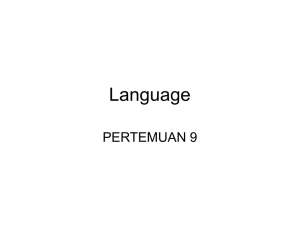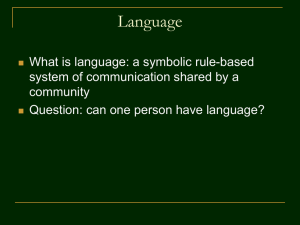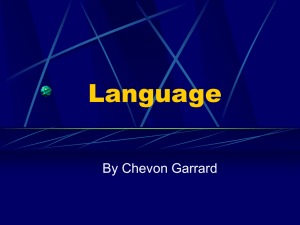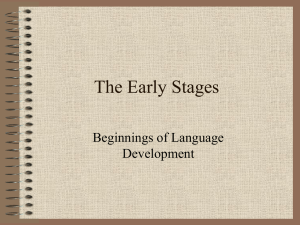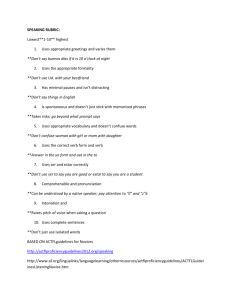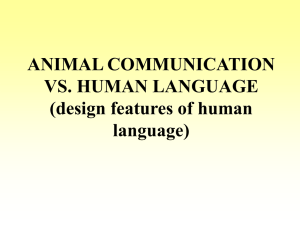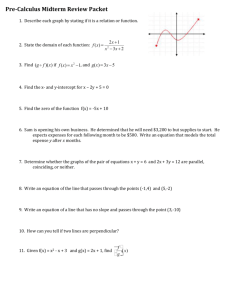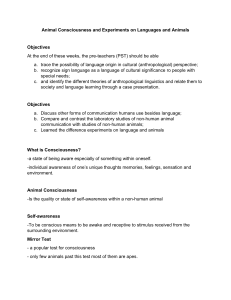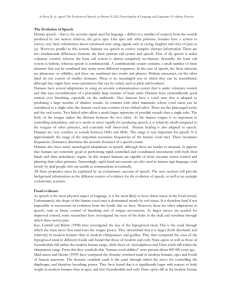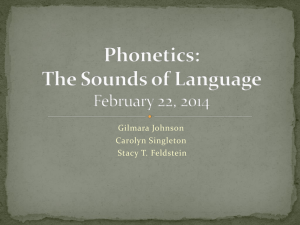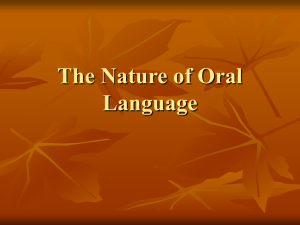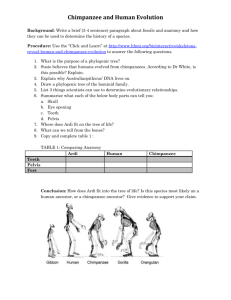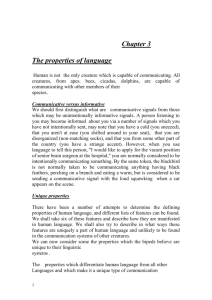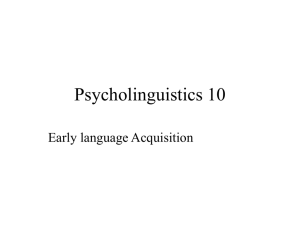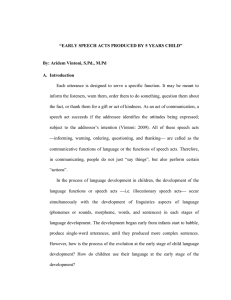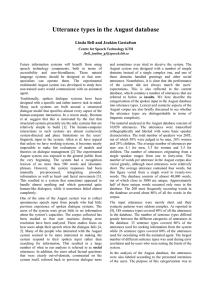What is language?
advertisement
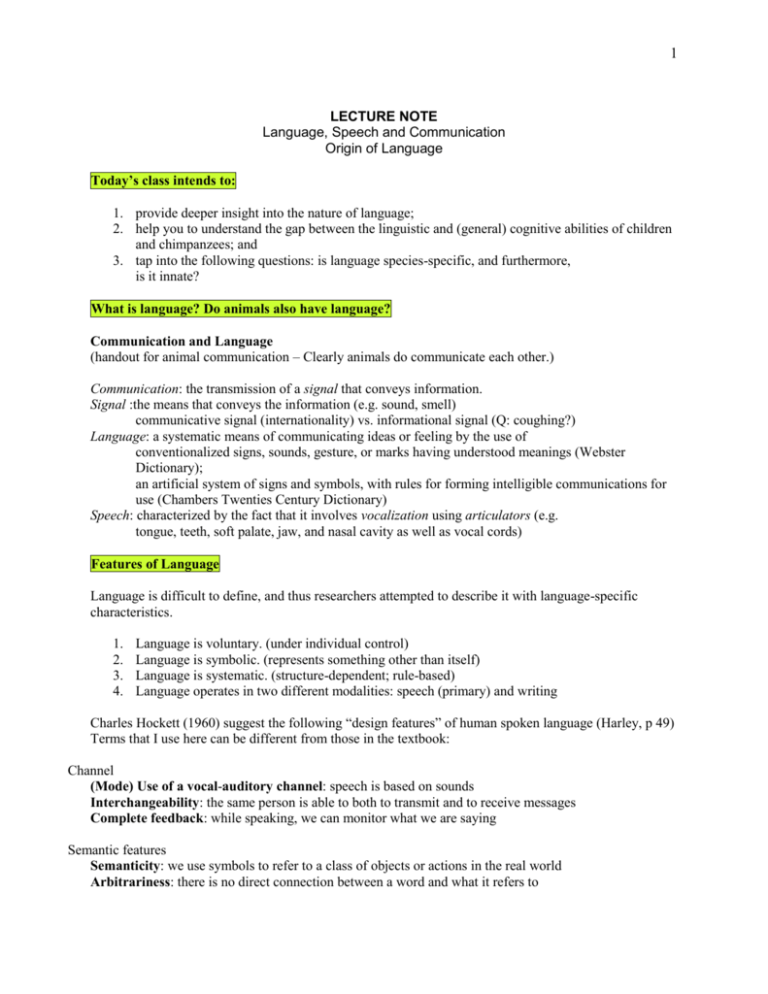
1 LECTURE NOTE Language, Speech and Communication Origin of Language Today’s class intends to: 1. provide deeper insight into the nature of language; 2. help you to understand the gap between the linguistic and (general) cognitive abilities of children and chimpanzees; and 3. tap into the following questions: is language species-specific, and furthermore, is it innate? What is language? Do animals also have language? Communication and Language (handout for animal communication – Clearly animals do communicate each other.) Communication: the transmission of a signal that conveys information. Signal :the means that conveys the information (e.g. sound, smell) communicative signal (internationality) vs. informational signal (Q: coughing?) Language: a systematic means of communicating ideas or feeling by the use of conventionalized signs, sounds, gesture, or marks having understood meanings (Webster Dictionary); an artificial system of signs and symbols, with rules for forming intelligible communications for use (Chambers Twenties Century Dictionary) Speech: characterized by the fact that it involves vocalization using articulators (e.g. tongue, teeth, soft palate, jaw, and nasal cavity as well as vocal cords) Features of Language Language is difficult to define, and thus researchers attempted to describe it with language-specific characteristics. 1. 2. 3. 4. Language is voluntary. (under individual control) Language is symbolic. (represents something other than itself) Language is systematic. (structure-dependent; rule-based) Language operates in two different modalities: speech (primary) and writing Charles Hockett (1960) suggest the following “design features” of human spoken language (Harley, p 49) Terms that I use here can be different from those in the textbook: Channel (Mode) Use of a vocal-auditory channel: speech is based on sounds Interchangeability: the same person is able to both to transmit and to receive messages Complete feedback: while speaking, we can monitor what we are saying Semantic features Semanticity: we use symbols to refer to a class of objects or actions in the real world Arbitrariness: there is no direct connection between a word and what it refers to 2 Discreteness: language is based upon a vocabulary of independent, movable units Displacement: we use pseech to refer to things in other times or places Learning Cultural transmission: one generation transmits speech to the next Learnability: we can learn additional languages from those who speak them Structure Creativity: we can form an infinite range of utterances, many of which we have never heard or said before. Duality of patterning: smaller units are combined into larger units Structure dependence: all known language have a hierarchical phrase structure Use Control: speech is used intentionally, unlike many involuntary sounds Specialization: the forms of speech (sounds, words) serve no other purpose Spontaneous usage: speech does not need to be premeditated Prevarication: we can use speech to tell lies Reflectiveness: we can use language to comment on language Ape language study: Can we teach language to animals? Gua Viki Washoe Nim Chimpsky Koko Kanji (son of Matata) Kellogg and Kellogg, 1933 female chimpanzee, cross-fostering, never produced recognizable words Hayes, 1951 female chimpanzee, cross-fostering, four poorly articulated words (“mama”, “papa”, “up”, “cup”) using her lips after 6 years Gardner & Gardner 1969, 1975 female chimpanzee (caught in the wild; 1 year old), American Sign Language (ASL) Age 4: produced about 85 signs, comprehended more Age 5: 132 signs Novel combinations (e.g. water bird) Some sensitivity to word order (e.g. distinguish “You tickle me” and “I tickle you”) Indication of cultural transmission (adopted son Loulis) Terrace, Petitto, Sanders, and Bever (1979) ASL 125 sings 2,000 utterances recording in 2 years; many of them of two or more signs in combination 90% of his utterances were in reply to his trainers (Rarely signed spontaneously). 40% of his utterances were simply repetitions of signs that had just been made by his trainers. Patterson, 1972, Gorilla; Video Showing (“Signs of the apes, songs of the whales”) While you are watching the video, focus your attention on the issues as follows: 1. Do you think Koko is cognitively intelligent enough to learn a language? 2. Do you think Koko uses the signs like humans do? Greenfield & Savage-Lumbaugh (1986, 1994), Bonobo; Video Showing (“Can chimps talk?”) While you are watching the video, think about the following issues: 1. Do Kanzi’s achievements convince you that other primates besides humans are capable of language? 2. How different is the language behavior between Kanji and human children? 3 Origin of Language 1. Three views on how speech and language evolved: a. Evolution of the brain and body (brains and vocal apparatus development first language later; nativists’ view) Cognition first – language later Continuity or Discontinuity? b. Evolution of language (simple noises primitive language brain and vocal apparatus development more sophisticated language; also innateness assumption?) Simple language first – Cognition later (ape language business – to attempt to find the precursor of the current human language) Continuity hypothesis (Darwinian): we cannot conceive of language as having no precursors c. The ‘big bang’ (language came about when human brain evolution took a lucky direction and we developed an innate language faculty) Discontinuity approach Chomsky: anti-evolutionary; discontinuity position (closest to “big bang” approach) learning vs. acquisition
